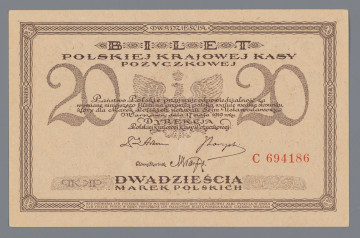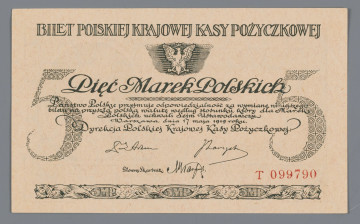
20 Polish marks
1919
National Museum in Lublin
Part of the collection: Paper money during the Second Polish Republic
Poland, uniting after a period of captivity, included areas where different legal, economic, financial and monetary systems of the partitioning states operated. The unification of the country's currency was one of the most urgent tasks for the young state. At the end of February 1919, it was decided that, once the economic situation had stabilised, Bank of Poland would be established, and the zloty would be the national currency. In the interim, the role of the banking institution was to be played by the Polish National Loan Fund (PKKP), still established by Germany, which issued Polish marks (mkp). The occupying Polish marks did not lose their validity. Ruined by the war, the country still had to tolerate issues from the partitioning states for several years. Their total value is estimated at 17,200,000 interwar zloty, which in 1924 was equivalent to almost 5 tonnes of gold. The mkp gradually became the sole means of payment in the former German partition (on 20 November 1919) and in the former Austrian partition (in the spring of 1920). The Russian ruble lasted the longest, being invalidated in the Borderlands only in July 1921.
While the graphic design of the first pro-independence banknote with the face value of 500 mkp drew directly on the occupation patterns, the subsequent issues from the first half of 1919 were original designs, which revealed the talent of the outstanding Polish graphic artist Adam Jerzy Półtawski (1881-1952), the creator of the Polish typeface (antique Półtawski). He was the author of numerous works in the field of illustration and book graphics, an award-winning creator of ex-libris and a distinguished teacher of graphic arts and an editor of magazines on this subject. In the first years of independence, he was associated, among others, with the Graphic Works of the PKKP and with the Graphic Works of Bolesław Wierzbicki in Warsaw, for which he designed banknotes with denominations of: 1, 5, 20 and 100 mkp. On the reverse of the 1 mkp banknote one can find the letters A P, with which the designer signed his works.
This banknote, printed in the State Printing House in Vienna and in the Printing Works of PKKP, was in use from 18 March 1920 to 1 July 1924. Apart from the graphics, which were difficult to forge, it was protected against forgery by a watermark in the form of a bee net.
In March 1920 a suit was offered for 20,000 mkp, and for 200,000 mkp a German-made single-cylinder NSU motorbike.
Tomasz Markiewicz
Author / creator
Dimensions
cały obiekt: height: 110 mm, width: 70 mm
Object type
paper money
Technique
Material
paper
Creation time / dating
Creation / finding place
Owner
The National Museum in Lublin
Identification number
Location / status

1919
National Museum in Lublin

1919
National Museum in Lublin

1923
National Museum in Lublin
DISCOVER this TOPIC
National Museum in Lublin
DISCOVER this PATH
Educational path